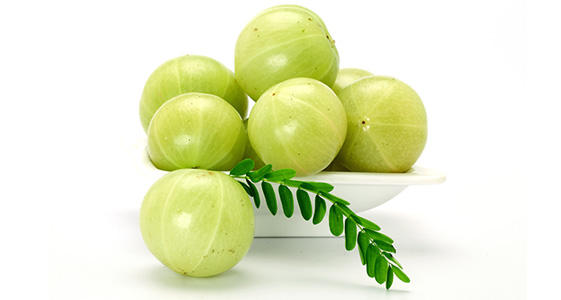
 Amla is a deciduous tree that grows up to 20 to 30 feet high. Its botanical name is Phyllanthus emblica or Emblica officinalis. The tree is usually found in India and Nepal and this is why it is often referred to as the Indian or Nepalese gooseberry.
Amla is a deciduous tree that grows up to 20 to 30 feet high. Its botanical name is Phyllanthus emblica or Emblica officinalis. The tree is usually found in India and Nepal and this is why it is often referred to as the Indian or Nepalese gooseberry.
The word "amla" is derived from the Sanskrit word "amlaki". The tree is best known for its round, small and green fruit. The fruit has a sour and bitter taste. Except for the seed, all parts of the amla fruit are edible.
A major ingredient in most ayurvedic products, especially the Chyavanprash and the Triphala churna, amla is a potent fruit known for promoting health and longevity.
Amla, aonla or Indian gooseberry (Emblica officinalis) is an indigenous fruit to the Indian subcontinent. Owing to hardy nature, suitability to various waste lands, high productivity/unit area (15-20tons/ha), nutritive and therapeutic value, amla is becoming more and more commercially important with every passing year.
Amla fruits are a very rich source of vitamin C having an ascorbic acid content varying from 0.9 to 1.3 per cent. This is the second highest among all the cultivated fruits. This fruit is highly valued among indigenous medicines. It is acrid, cooling, refrigerant, diuretic and laxative. Dried fruits have been reported to be useful in haemorrhages, diarrhea, dysentery, anaemia, jaundice, dyspepsia and cough.
Trifala and Chyavanprash are well known indigenous medicines in Ayurvedic system using amla fruits.
Amla is rich in vitamin C. A glass of amla juice contains twenty times more vitamin C than a glass of fresh orange juice. So, you can easily see why amla is so revered in Ayurveda. It is the richest source of vitamin C.
The fruit is also rich in proteins and fibers. It contains minerals such as iron, calcium, and phosphorus besides vitamins A and B.
The rich vitamin C content of this fruit makes it one of the strongest immune boosters available to mankind. This means that regular intake of amla will prevent you from all kinds of bacterial, viral and fungal infections.
Its cooling properties make it ideal for treating all kinds of skin disorders. So, if you are looking for a natural cure for your acne, give amla a try. It slows down the appearance of wrinkles and fine lines.
The fruit promotes longevity and slows down the aging process. Its strong antioxidant properties have a protective effect on your heart, lungs, brain, and skin.
Amla is considered to have a beneficial effect on respiratory disorders as well. It has been found to alleviate asthma symptoms.
Due to its beneficial effects on the secretion of insulin, amla is believed to control blood sugar levels in diabetic patients. Its rich chromium content is another reason why it is good for diabetics.
Andhra Pradesh
Gujarat
Nagpur
Maharshtra
Amla is a subtropical plant and prefers dry subtropical climate. Even mild frost during the winter months can be injurious to tree. Though it can bear temperature upto 46 C during summer months, but the temperature should not be high at the time of flowering. It affects fruit setting and may sometime lead to complete unfruitfulness, if there are hot and dry winds too. Ample humidity is essential for initiation of fruit growth of dormant fruitlets during July –August. Dry spells result in heavy dropping and delay in initiation of fruit growth.